Industries

As business delinquencies rise in response to COVID-19, credit departments are becoming increasingly challenged. In our August 13th Sip and Solve webinar, John Krickus and Andrew Moore will be on hand to share some strategies for maximizing receivables amid rising delinquencies. Managing receivables has never been more important or more challenging. Traditional approaches may no longer apply. In this 15-minute Sip and Solve session, we discuss some solutions for effectively and efficiently handling the increase in receivables many companies are facing. After watching this talk you will learn three key takeaways: Prioritizing receivable management in today's environment Analytic tools for managing receivables Flexing receivables strategies to meet your company's priorities Click to view full slides and transcripts from this session.
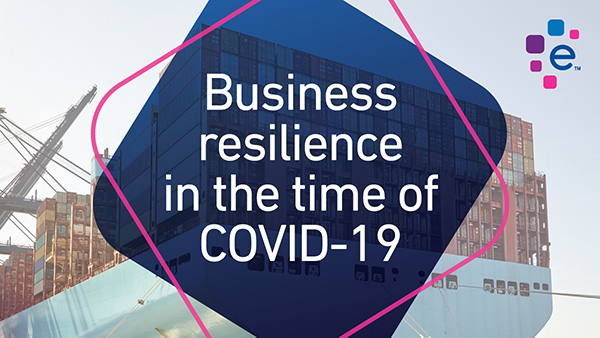
In a favorable economic climate, business resilience is often treated as an afterthought. Success is measured in rapid growth and leaps of progress, while failure is little more than a tempering of that expansion. It’s only when things slow down - like during a global pandemic - that companies are forced to take stock of the ground they stand on. As the economy slows to a crawl and entire industries feel the squeeze, business resilience will determine which organizations make it through to the other side. Whether you’re on the supply side or the demand side, chances are your organization is being tested right now. Here are some practical strategies to stay resilient in the time of Covid-19. Gerard Smith, President of Global Risk Management Solutions (GRMS), works with companies who are either on-boarding new suppliers or evaluating current suppliers. When the Covid-19 pandemic disrupted supply chains in most industries, many of these companies started scrambling to find replacement suppliers. Finding a reliable supplier is always a challenge, but it’s even more difficult during a global pandemic and economic crisis. The best practice here is still to vet new suppliers carefully. Smith’s company creates a risk assessment program for Experian clients that analyzes 50 different financial and legal components, including the following: If they’re on the OFAC sanctions list If they’re financially stable If they actually have the certifications they claim to have If they have insurance If they’ve received negative press Many companies fail to do their due diligence when it comes to suppliers, especially if they’re trying to fulfill orders quickly. More often than not, this leads to bigger problems down the line. If you hire a supplier that’s hemorrhaging money, for instance, they may file for bankruptcy right after you pay them for a major shipment. Companies that use GRMS will be notified regularly if a supplier’s financial or legal status changes. If a supplier cancels their insurance coverage, for example, that could indicate financial struggles. Staying abreast of information like this allows businesses to be proactive with suppliers and avoid being blindsided. Make Sure Clients Are Financially Healthy On the flip side of the buyer-supplier relationship, suppliers are now being asked to extend due dates. Deciding how to comply with these requests can be tricky. Most want to be understanding and reasonable, but there is often legitimate concern over whether they’ll receive payment. Brodie Oldham, Senior Director of Analytic Consultancy for Experian, said Experian offers several services for suppliers who need to gauge how reliable their customers are in this moment. Experian has a special Covid-19 risk index that suppliers can overlay on top of existing credit models. This tool can help determine whether or not a client is in an unstable financial position. If the company operates in a highly impacted part of the country or industry, the supplier can use that information to change the terms. For example, they can sell fewer items to minimize the risk of an unpaid invoice. Experian also monitors credit utilization for business credit cards and other lines of credit. If a company’s credit utilization surpasses a certain threshold, they can alert the supplier who can halt future shipments until the utilization decreases. Find Faster Ways to Evaluate Creditworthiness Many suppliers depend on a company’s credit information to determine its reliability as a buyer. Likewise, credit bureaus are being forced to reevaluate their models in response to the changing business landscape brought on by Covid-19. Enter the agile credit function. The term agile has traditionally been used in the context of software development to describe an iterative approach where requirements and solutions evolve through collaboration between cross-functional teams. It allows companies to adapt to new requests quickly and improve time-to-market. Agile is all about being nimble and responsive - something credit bureaus are prioritizing in today’s uncertain economy. Agile credit means finding new, faster ways of evaluating customers and determining their ability to pay, in a time when that information can change daily. “When everything shut down in March, credit people got thrown for a loop,” said Dan Meder, Vice President of Consulting, Product Marketing and Alliances for Experian Business Information Services. “They needed a way to manage that change very quickly.” That’s where having an agile credit approach comes in. “It’s about using agile principles in your credit function to respond more quickly to changing market needs,” Meder said. Using an agile credit system helps suppliers decide what kind of terms to offer their customers. Many companies are asking suppliers to extend their terms and due dates, often switching from net-30 to net-60. Suppliers then have to decide if they can trust these companies to repay them within that longer time frame, Meder said. If companies in this position use an agile credit function, they can be more responsive and confident in the terms they set out because they’re basing their credit policies on the current state of their customer environment. This requires operating with the latest possible information on how current economic conditions are affecting their customers. Meder said that making credit function more agile requires direction from the head of the credit department and other members of that department. They can also utilize software programmers if the automatic process needs to be updated or any outside consultants for specific analytical expertise. “The idea is to bring together a team of people with direct involvement in managing the credit function to assess how best to manage the customer experience given the current state of the customer environment,” he said. “This includes setting policies around risk assessment as well as credit terms and collection processes.” Meder said companies should have technology that allows them to tinker with their credit function so they can make changes quickly. “This is especially true in a fast-changing or uncertain environment such as what we are seeing with COVID-19 and the uncertain effect it is having on our economy’s future,” he said. “In fact, it is turbulent times such as these where being “agile” is most important since the credit department needs to be able to alter course quickly if the customer environment changes for better or for worse.” Consider Being Flexible With Clients While delayed payments from clients is upsetting, avoid taking your current client relationships for granted. While a more stringent approach from suppliers is understandable right now, Meder cautions companies to remember that the pandemic will end at some point. At that time, companies will remember which suppliers were flexible about payments, due dates and terms - and which companies weren’t. “If you weren’t good to them while they were struggling, they’re going to forget about you when things turn around,” Meder said. To find out how fine-tuning your company’s credit function can help it weather the current economic crisis, reach out to your Experian representative.
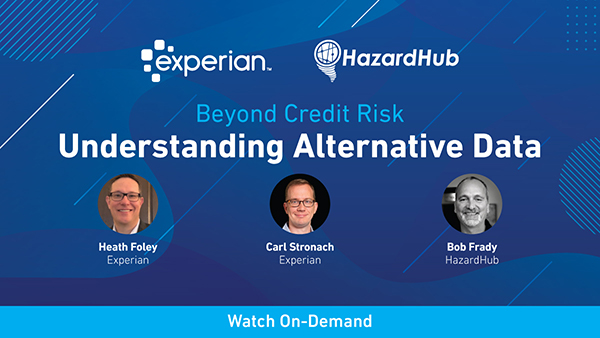
When insurance underwriters make mistakes, bad policies can cost billions. Alternative forms of data is helping change those outcomes, particularly for insurance providers in helping them identify blind spots and accurately underwrite policies. Watch our special Insurance-focused webinar titled "Beyond Credit Risk - Understanding Alternative Data" with HazardHub. Heath Foley and Carl Stronach from Experian is joined by Bob Frady from HazardHub during this lively discussion. Alternative sources of data are growing in importance in the market. The key to our data platform is constantly investing and sourcing a wider variety of data such as geographic hazards, social media, and OSHA data in order to represent a fuller picture of the health of the business. In this one hour talk, we walk through: Utilizing property-level hazard risk assessments The growing importance of alternative sources of data How to bring superior data to power comprehensive insights Related information What is alternative and non-traditional data/
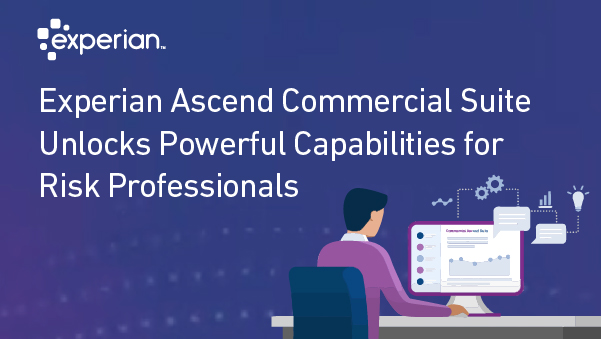
Experian® today announced Ascend Commercial Suite™ for financial institutions specializing in commercial lending as well as insurance carriers to drive growth while reducing risk. The suite includes Experian’s Ascend Analytical Sandbox™ configurations and a new Ascend Commercial Benchmarking Dashboard™ that provides access to industry-leading data on small and midsize businesses. “Experian is committed to creating opportunities for businesses to succeed,” said Hiq Lee, president of Experian’s Business Information Services. “During uncertain times, making fast, accurate decisions is critical for lenders so they can continue to extend credit responsibly to the businesses that need it most. Experian’s Ascend Commercial Suite enables clients to access world-class advanced analytics, AI, machine learning, and benchmarking tools so they can make real-time decisions that can ultimately help businesses on the road to recovery ahead.” Experian’s Ascend Analytical Sandbox is an industry-leading cloud-based data and analytics solution that offers flexibility in addressing lenders’ needs and offers instant access to up to 19 years of data. The secure hybrid-cloud environment allows users to combine their own data sets with Experian’s exclusive data assets, including consumer credit, commercial credit, nontraditional, auto, and more. Small and midsize business lenders, as well as insurance carriers, can seamlessly blend commercial and consumer small business data to get a 360-degree view of their overall small business portfolio to more easily identify risks and opportunities. It’s a one-stop-shop for insights, model development, and results measurement. The Ascend Commercial Benchmarking Dashboard delivers a comprehensive visual dashboard view of credit risk data and Small Business Financial Exchange™ (SBFE) Data exclusively for SBFE members. Clients can compare their portfolios against industry performance and analyze new market segments for potential growth and expansion. The insights available through the Ascend Commercial Suite can be viewed and shared through interactive dashboards and customizable reports. Additional use cases include: Portfolio performance and monitoring: Lenders can harness the power of Experian data to better monitor performance and quickly identify areas of strength or concern on visual dashboards without having to run custom reports every month. Model development and validation: Clients can monitor existing models and develop new models in order to improve risk profiles of new accounts and improve existing accounts. Blended analysis: Small business lenders relying on personal guarantees can use both consumer and business data to determine a customer or potential customer’s overall risk. Marketing analytics and acquisition: Lenders’ campaign information and results combined with Experian’s Credit Risk Database help them understand performance and improve marketing and segmentation. Decisioning for risk assessment and segmentation: Lenders and insurance carriers can optimize risk decisioning and segmentation strategies using analytical tools on one platform, which provides quick and efficient access to multiple integrated data sets. Reject inferencing: Lenders can load application data and use SBFE trade-level data to understand how declines performed if customers obtained credit elsewhere. Custom attributes to better analyze portfolios: With SBFE Data, lenders can create their own custom attributes or use Experian’s highly predictive set of attributes. Experian’s Ascend Commercial Suite is built on the Experian Ascend Technology Platform™. Launched in 2017, the Experian Ascend Technology Platform is recognized as one of the most successful launches in Experian’s history. It’s currently being used by the top financial institutions globally including the United Kingdom, South Africa, Brazil and Asia Pacific. Experian’s Ascend Analytical Sandbox was also selected in 2019 as the winner of the “Best Overall Analytics Platform” award by FinTech Breakthrough, an independent organization that recognizes the top companies, technologies and products in the global fintech market. To learn more about Experian’s Ascend Commercial Suite, please visit: https://www.experian.com/business-information/ascend-commercial-suite.
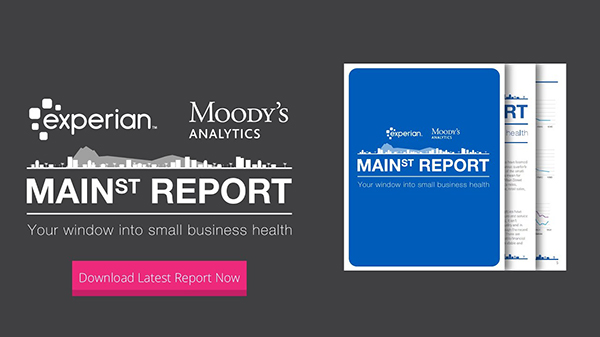
Experian and Moody’s Analytics have just released the Q1 2019 Main Street Report. The report brings deep insight into the overall financial well-being of the small-business landscape, as well as providing commentary on what certain trends mean for lenders and small businesses. In Q1 U.S. small businesses brushed off a government shutdown as stock markets recovered and income gains remained steady. Delinquency rates remained mostly stable, with pockets of weakness spread out among regions and industries, notably agriculture in the Great Lakes and manufacturing in the Southwest. Small firms seem to have simply shrugged off the headwinds of the first quarter and kept on with business as usual. Despite a fresh escalation in trade tensions, the year is starting off well with positive news coming from the areas presenting risks to the outlook. A dovish stance on interest rates from the Federal Reserve and room to grow in our housing market — 2019 is off to a strong start. Watch Webinar Recording - Q1 2019 Quarterly Business Credit Review Listen to the experts from Experian and Moody's Analytics go in-depth on insights revealed in the Q1 2019 Experian/Moody's Analytics Main Street Report.

Serving commercial Property & Casualty insurers is a major objective of 3rd parties in the analytics and data space. This industry vertical is one in which standard credit tools already apply to the carrier’s challenge in managing claims risk; there is continued investment within and beyond the industry in developing innovative tools for this purpose. However, a smooth roll out of such tools at scale requires a comprehensive understanding of the regulatory process and its constraints. US Insurance industry- overall regulatory structure: Currently, US carriers are regulated primarily by the individual states, a result of the 1945 McCarran Ferguson Act (“MFA”). Less known is that the MFA was presaged by the Paul v Virginia decision (1869, later overturned by SCOTUS) that held that issuing an insurance policy was not a commercial transaction! [1]. Federal regulatory guidance, ultimately from the Office of the Controller of the Currency (OCC) and the Federal Reserve Board (FRB), is implemented via the National Association of Insurance Commissioners (“NAIC”; see below). NAIC organizes the insurance commissioners from all 50 states, Washington DC, and territories. NAIC maintains legislative databases, market conduct standards, industry financial reporting, conducts training, and many other functions. NAIC provides supervisory guidance for the use of models used to predict insurance loss risk. Among other functions, NAIC has created the Own Risk and Solvency Assessment (“ORSA”) framework which implements existing OCC and FRB guidance to the states. Capital reserves needed for solvency as well as business conduct -- including product definition and general business operations, licensing, maintaining a guaranty fund, underwriting, and rate setting-- are determined primarily by the states in which the carrier operates [2]. Today’s system of state-by-state regulation is more challenging than an equivalent centralized regulating body; insurance carriers operate increasingly online, driving the need for multi-state operations which in turn require multistate licensing and complex regulatory compliance. The average property liability firm has 16 state licenses, while the average life insurance carrier has 25. The coordination of state insurance laws, as well as many other quasi-governmental insurance industry functions, falls under the aegis of the NAIC. We will focus our discussion here on the regulation of risk models. How should third parties align the model building with regulatory requirements? Example 1: Basic filing and disclosure protocol: Responsibility to disclose to state regulators typically lies with the developer or the owner of the model. Disclosure responsibility for custom risk models built around the data of a specific client insurer resides with the insurer, while industry standard models used for multiple clients are typically disclosed by the model developer. Reporting and disclosure requirements vary by state. While the most central functions of interest by state regulators are underwriting and rate setting, any other use of models by insurers may be subject to regulatory disclosure. Models used to assess loss risk for rate setting or underwriting purposes are typically examined for discriminatory impact and use of prohibited data in addition to adequate risk performance and numerical stability. “Prohibited data” varies by state but may include certain data elements gleaned from in-state residents, federal crime data, certain credit data elements, traffic violations exceeding a specified age on the books, or other data; the section below deals with credit data. Finally, the requirement to disclose model details such as attributes and weightings also vary between states, and may require the developer to invoke trade secret status for the subject models to avoid disclosure to the public (implicit in many states). The adjudication of such claims is variable between states, as are all communications with regulators on this topic. Example 2: Use of consumer credit information to underwrite personal insurance policies: Using credit information in models to predict loss risk on personal insurance contracts also has a rich and extremely active history in the US. P&C insurers have generally found that credit risk and claims risk are positively correlated. They have used credit data on individual consumers to various degrees. Notably, the Consumer- Based Insurance Score (CBIS) employs consumer credit parameters and has been used across the insurance industry since 1993. Amid vigorous debate, states have seen active legislative attempts to restrict and define allowable use of consumer credit data by insurers. Credit information in some cases can outweigh a consumer’s driving record in setting rates- leading to the bitter but factual observation that excellent consumer credit can literally outweigh a DUI conviction in some states and conditions. In 2016 alone, the state legislative actions below were considered and/or enacted; note once again that the ability of individual states to regulate independently greatly complicates the picture for large carriers operating in multiple states: California, Hawaii, and Massachusetts do not appear in the table above. In those states, consumer credit information cannot be used to underwrite personal auto policies. Example 3: Reporting channel: State regulators typically require use of the System for Electronic Rate and Form Filing (“SERFF”) database maintained by NAIC for formal submissions: https://login.serff.com/serff/ What’s coming down the road? We have seen examples of the dependence of applicable insurance regulations on individual state laws; the mechanics of model development requires understanding and working with these restrictions. Basic filing and disclosure, permissible model variables, the proprietary status of model detail, and the use of certain consumer information (e.g., credit scores, driving records) are all aspects of risk models whose successful execution depends on understanding the widely variable set of existing state regulations. Several authors have cited the need for a shift in the underlying regulatory structure of the industry from state-based to a national system, citing the inefficiency of the licensing process and the true interstate nature of today’s distribution system. A centralized federal insurance regulatory body would simplify interstate compliance by carriers, but would also introduce other complications. However, it appears prudent in the near-term for 3rd parties developing models to gain awareness of, and streamline, current requirements for regulatory compliance at the state level. Conclusion: There is a considerable additional value that the next generation of models will contribute to the commercial P&C vertical. Insurers and 3rd party developers have demonstrated the applicability of their models and data reports, offering competitive added value with standard risk scores adapted from the credit domain. However, promoting these products more broadly and expanding the product offerings themselves into cyber risk, commercial linkages, and various other tools for insurers, the insurance industry faces efficiency hurdles from our 50-state regulatory framework. With any regulatory centralization unlikely near term, 3rd parties thus need to gain working fluency in NAIC and in the SERFF database, anticipate state-level documentation and disclosure requirements, and attain a level of familiarity with state regulatory machines that enables the management of the interests of their clients with confidence. How Experian can help you Experian provides analytical services for Property & Casualty as well as other insurance product verticals. To enable you to assess claims risk at the time of policy application (or renewal), we either apply standard risk models or develop custom risk models to your underwriting and rate-setting processes. To help you guard against cyber fraud, false identity, and reputation risk, we offer specialty products as well. We also offer special purpose, custom analyses on request, and we sell curated commercial data to your standards as well. References: [1] Brookings Institute. paper on future of regulation- Grace & Klein [2] Insurance Information Institute: Regulation [3] Grant Thornton: ORSA requirements: Model Risk Management for Insurance Companies [4] Blueprint for a Modernized Financial Regulatory Structure, Dept. of Treas., 2008
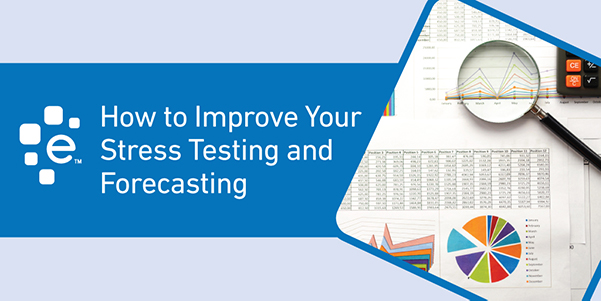
I have been on the road meeting with clients at advisory events, forums, and industry thought leadership conferences, and what I continue to hear is a concern about the upcoming recession. The drivers of the next recession are up for debate but the consensus is that it is inevitable. The U.S. Economy is complex and the signals are mixed as to where the greatest impact will be felt. Protecting your business, whether consumer or commercial focused, is dependent on the stability and strength of your lending criteria and customer engagement practices. You want to protect your customers as well as your business in the case of a market stumble. You are laser-focused on making the best possible decision when reviewing credit applications and setting loan terms, however, financial situations change over time for both individuals and companies. This is especially true when a recession hits and unemployment begins to rise, consumers stop spending, and commercial delinquencies begin to rise. When these macroeconomic changes occur, the credit you have extended to your portfolio might be at under market stresses and at a stronger risk of nonpayment, and this can affect your business’s health and sustainability. By stress testing your portfolio, you can determine what may happen, when stresses are exerted, by a receding economy, on your portfolio. You can use credit information, macroeconomic data, and alternative data to build models that forecast what is likely to happen in the future and how stresses, will affect the ability for people or businesses to pay their bills. While larger regulated companies may be required to perform forecasting and stress testing, lenders of all size can benefit from the process. Gathering the Right Data for Accurate Stress Testing The accuracy of your stress test depends on the type and quality of data used for forecasting. Recessions are cyclical and likely to re-occur every few years, it is recommended that companies use historical data from the 2008 recession for analysis and to make accurate predictions. Young businesses may not have complete historical data going back to the 2008 recessionary time period. A partner like Experian can create look-alike business samples, from the vast holistic data, to simulate the likely impact of macroeconomic scenarios. For example, a financial services firm has been providing small business loans between $50,000 and $100,000 for the past three years and wants to predict future losses. To gather the data for loss forecasting, you need to create a business and product profile identifying loans or businesses with similar characteristics, to stress and forecast performance. These profiles are used to build a look-alike sample of businesses and loan products that look and perform like your current portfolio and will add the sample size and retro time periods needed to create a statistically viable analysis sample. Selecting a Forecasting Strategy Once you have the historic credit, macroeconomic, and alternative data on your portfolio or look-alike retro sample for modeling, you need to stress test the data. Most stress test analyses start with a vintage based analysis. This type of analysis looks at the performance of a portfolio across different time periods (Example: March 2007, March 2008, March 2009, etc..) to evaluate the change in performance and the level of impact environmental stresses have on the portfolio's performance. Once you have this high-level performance, you can extrapolate into the future performance of the portfolio and set capitalization strategies and lending policies. Identifying Loss Forecasting Outcomes Regulators and investors want to know the business is solvent and healthy. Loss forecasting demonstrates that your company is thoughtful in its business processes and planning for future stresses. For regional lenders that are not regulated as closely as large national or global lenders, forecasting shows investors that they are following the same rules as larger regulated lenders, which strengthens investor confidence. It also demonstrates effective management of capital adequacy and puts you on a level playing field with larger lenders. Companies with limited data can start with credit data for look-alike sample development and add historical data and alternative type data as they grow for a holistic portfolio view. Setting up Governance Business policies and macroeconomic stresses change over time, it’s essential to set up a governance schedule to review forecasting processes and documentation. Your stress testing and forecasting will not be accurate if you design it once and do not update it. Most companies use an annual schedule, but others review more frequency because of specific circumstances. Effectively Documenting Loss Forecasting The key element of loss forecasting is effectively documenting both sample and strategy taken in the evaluation of your portfolio. A scenario you might face is when a regulator looks at the analysis performed and you have selected sample data at the business level instead of the loan level, documentation should capture the explanation of why you made the decision and the understood impacts of that decision. While the goal is to have complete data, many companies do not have access to high-quality data. Instead of foregoing loss forecasting, the use of documentation to note the gaps and build a road-map for the data can be of great value. Here are additional key points to include in the documentation: • Data sources • Product names • Credit policies • Analysis strategy • Result summary • Road-map and governance schedule By creating a stress-test analysis strategy for forecasting loss, your company can make sure its portfolio and financial status remain as healthy tomorrow as they are today while maintaining transparency and investor confidence. The next recession is out there, this is a great time to strengthen processes for future successes.
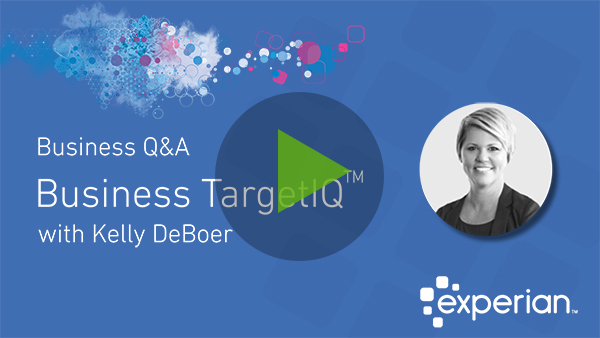
Experian Business Information Services recently introduced a powerful new marketing platform called Business TargetIQ. Product Manager, Kelly DeBoer answered a few questions about the product and described use cases that promote greater collaboration between credit and marketing departments. What does Business TargetIQ do? Business TargetIQ is our new marketing platform so it's a B2B marketing platform where clients can access data for marketing applications. How is it different from other business marketing platforms? It is unique in that it not only includes your standard or core firmagraphic information but also includes Experian's credit attributes. Does it have credit data? What does that mean to marketing or collaboration? Typically marketing data and credit data are housed in separate silos of information. With this tool the information will be combined together which will allow the tool not only to be used in traditional marketing applications for targeting but can also be in that risk factor which applies to different divisions within our client's applications or use cases of the data. Who would most benefit from Business TargetIQ? The thing about Business TargetIQ is it truly applies to all different verticals, as well as all different contacts within the company. So whether it's a financial vertical or a trade vertical, retail, just across the board all clients can utilize this. Anybody that's doing marketing can utilize this platform. What core problems does Business TargetIQ solve? It solves a lot of different problems, so, the most common client issues that are brought to our attention are gaps in data, as well as in the marketing initiatives. So they may have data in-house but they have holes within the data. Our tool will allow them to not only upload their client records and fill in a lot of those gaps that they may have, whether it be contact information, or firmagraphics or address information. It will standardize that data and fill in those gaps. But will also provide the means to again use that data. Our business database which has over 16 million records. They can then utilize that information for prospecting, for data append, for analytics, for research applications, so it solves a lot of problems with regard to marketing and data concerns. How does credit data help with prospecting? So what we find is clients come to us and they may say you know I have an idea of what our clients look like, they're in this SIC or in this industry code, or they have this sales volume or employee size, but what they may not know is on the back end which really helps identify and target those businesses is the credit attributes, so the risk factors around those. So do they have delinquencies in their payments? Have they filed bankruptcies? Do they have UCC filings? So it allows them to take it that next step and not only really define what their clients look like, but identify clients that look like that. Learn More About Business TargetIQ

As a Senior Consultant with Experian Advisory Services, Gavin Harding works closely with many of Experian's FinTech and Financial Institution clients to find solutions to complex problems. We sat down recently to talk about bank partnerships, how they come about, what makes them successful, and how Experian supports them. Do you see a lot of collaboration between banks and FinTechs? The latest statistics show that 67 percent of banks and FinTech’s are either currently cooperating, or in discussions about cooperating, or exploring collaboration. So, yes a very significant proportion are considering collaborations. Why collaborate at all? You know it's interesting, they have different skill sets, different assets, different backgrounds. So for example; banks have really deep, broad customer relationships. You know think about your Mom or Dad bringing you to your local bank to open up your first account. Think about your student loan. Think about your mortgage. What kinds of relationships exist? So banks have really deep and broad relationships. But traditionally the experience with banks has not necessarily been great in terms of turnaround, in terms of the friction or pain involved in getting a loan or opening an account. On the other side, FinTech’s are really good at that customer experience. They describe it as either low or no friction. So very quick turnaround times. But they're very much transactional-focused, meaning single products. So FinTech has the technology and the experience, and banks have the depth of relationships with customers. You bring those two parts together and you've got a pretty amazing potential opportunity. There are as many relationship types shapes and sizes as there are people on the planet. Everything from cooperation on basic operations, meaning, a FinTech takes applications for a bank and then passes them on. All the way over to full-fledged integration of systems, personnel, capabilities, skill sets, and so on. So pretty much the broad spectrum. What works well? So it works really well when they are well-matched. So what I mean by that is, when the skill sets from one organization match the other. When one enhances the other, and it works really well when there are long and detailed discussions and preparations for the relationship. Meaning, they align and discuss goals, objectives, what each organization's role is, what each brings to the table, and very specifically how they are going to cooperate. What are the pitfalls? Well, the same pitfalls. So the pitfalls are that the relationship goals differ, or aren't aligned, or that one organization feels like they are bringing more to the relationship and that the partnership is equal, or when it feels as if each partner, each organization is not getting value from the relationship over time, and once again that reinforces the need for those detailed discussions before getting into that partnership or relationship. How does the process work? So it begins with a discussion. I've seen these partnerships start with a discussion over dinner at a conference. I've seen them start through a LinkedIn connection. I've seen them start over coffee. So it really starts with an exploration of who's out there? What organizations may be interested in even discussing some kind of collaboration? So it starts with the conversation at the very basic level, even when we see in the Wall Street Journal major strategic alliances between organizations, starts with people, and starts with that very simple conversation and connection. What are some key elements to be aware of? Well again it comes down to what each party brings to the relationship and what the goals are. So a good alignment of the capacity of skill sets, an alignment of investment in terms of time and resources, and very specifically a definition of who does what, what the accountabilities are, and what everybody's expectations are. They are fundamental to the success of any type of business arrangement or partnership. How does Experian support these partnerships? So the interesting thing is we have very deep relationships with both sides. So we bring data, solutions, consulting expertise to FinTech’s and to banks. So, it's really interesting we find ourselves in the middle of a lot of these conversations, and how we help is by understanding systems, technology, data, the best of both organizations involved in the conversations, and how to bring all of that together for a good focused efficient successful outcome. A couple of years ago this was new meaning that banks saw FinTech’s growing, and kind of looked at them a little bit maybe as competition, as potentially the enemy, FinTech’s saw themselves as disrupting the world and completely innovative and new. What's starting to happen is both sides are coming together, realizing that they are both part of the same financial industry, serving the same customers, maybe in different or new ways with different products. But in the same industry. So there is very much a coming together, an alignment a co-mingling, consolidation of all these various aspects of the industry. And I think it's really positive for consumers. More products, more quickly, and a better experience overall. Do you think a FinTech's ability to create more dynamic mobile experiences is a key element Certainly and so the big question we help banks answer in this space is, do we build it? Do we buy it? Do we partner? and build and buy or partner refers to the technology the infrastructure and the experience. So if you have a pretty big bank and they've got a old website, old process, lots of paper, lots of regulations, lots of pain in the process. Well they can look at one of the more advanced sophisticated mature FinTech’s and essentially use their platform, their engagement, their data, connect that to the bank's customers and in a very very short time transform that experience in a very positive way for their banking customers. Learn about FinTech Lending Solutions
